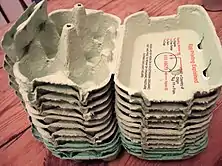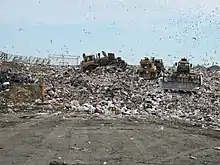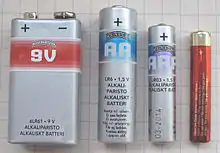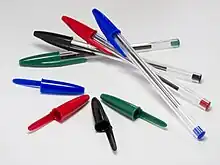Disposable product
A disposable (also called disposable product) is a product designed for a single use after which it is recycled or is disposed as solid waste. The term is also sometimes used for products that may last several months (e.g. disposable air filters) to distinguish from similar products that last indefinitely (e.g. washable air filters). The word "disposables" is not to be confused with the word "consumables", which is widely used in the mechanical world. For example, welders consider welding rods, tips, nozzles, gas, etc. to be "consumables", as they last only a certain amount of time before needing to be replaced. Consumables are needed for a process to take place, such as inks for printing and welding rods for welding, while disposable products are items that can be discarded after they become damaged or are no longer useful.

Etymology
"Disposable" is an adjective that describes something as non-reusable but is disposed of after use. Many people now use the term as a noun or substantive, i.e. "a disposable" but in reality this is still an adjective as the noun (product, nappy, etc.) is implied.
Disposable income is the amount of money left over from one's salary or pay for spending, saving or whatever, after all living costs have been taken out; this term uses the word "disposable" in a different sense, as the money is available to be "disposed" (i.e. allocated or committed) freely according to one's discretion.
Materials
Disposable products are most often made from paper, plastic, cotton, or polystyrene foam. Products made from composite materials such as laminations are difficult to recycle and are more likely to be disposed of at the end of their use. They are typically disposed of using landfills because it is a cheap option. However, in 2004, the European Union passed a law where they stopped allowing disposals in landfills.[1]

In 2021, Australia's Minderoo Foundation produced a report called the "Plastic Waste Makers Index" concluding that half of the world's single-use plastic waste is produced by just 20 companies.[2][3] China is the biggest consumer of single-use plastics.[4]
Examples of disposables
Kitchen and dining products

- Aluminum foil and aluminum pans[5]
- Disposable dishware / drinkware (e.g. plates, bowls, cups)[6][7][8]
- Plastic cutlery (e.g. spoons, knives, forks, sporks)[9]
- Disposable table cloth[10]
- Cupcake wrappers, coffee filters are compostable
- Drinking straws
Packaging
Packages are usually intended for a single use. The waste hierarchy calls for minimization of materials. Many packages and materials are suited to recycling, although the actual recycling percentages are relatively low in many regions. For example, in Chile, only 1% of plastic is recycled.[11] Reuse and repurposing of packaging is increasing, but eventually containers will be recycled, composted, incinerated, or landfilled.
There are many container forms such as boxes, bottles, jars, bags, etc. Materials include paper, plastics, metals, fabrics, composites, etc.
Food service industry disposables
.jpg.webp)
In 2002, Taiwan began taking action to reduce the use of disposable tableware at institutions and businesses, and to reduce the use of plastic bags. Yearly, the nation of 17.7 million people was producing 59,000 tons of disposable tableware waste and 105,000 tons of waste plastic bags, and increasing measures have been taken in the years since then to reduce the amount of waste.[12] In 2013 Taiwan's Environmental Protection Administration (EPA) banned outright the use of disposable tableware in the nation's 968 schools, government agencies and hospitals. The ban is expected to eliminate 2,600 metric tons of waste yearly.
In Germany, Austria, and Switzerland, laws banning use of disposable food and drink containers at large-scale events have been enacted. Such a ban has been in place in Munich, Germany, since 1991, applying to all city facilities and events. This includes events of all sizes, including very large ones (Christmas market, Auer-Dult Faire, Oktoberfest and Munich City Marathon). For small events of a few hundred people, the city has arranged for a corporation offer rental of crockery and dishwasher equipment. In part through this regulation, Munich reduced the waste generated by Oktoberfest, which attracts tens of thousands of people, from 11,000 metric tons in 1990 to 550 tons in 1999.[13]
China produces about 57 billion pairs of single-use chopsticks yearly, of which half are exported. About 45 percent are made from trees – about 3.8 million of them – mainly cotton wood, birch, and spruce, the remainder being made from bamboo. Japan uses about 24 billion pairs of these disposables per year, and globally the use is about 80 billion pairs are thrown away by about 1.4 million people. Reusable chopsticks in restaurants have a lifespan of 130 meals. In Japan, with disposable ones costing about 2 cents and reusable ones costing typically $1.17, the reusables better at the $2.60 breakeven cost. Campaigns in several countries to reduce this waste are beginning to have some effect.[14][15]
Israel is considered the world's largest user of disposables food containers and dinnerware. Each month, 250 million plastic cups and more than 12 million paper cups are used, manufactured and disposed.[16] In Israel there are no laws about manufacturing or importing of food disposable containers.[16]
A kulhar is a traditional handle-less clay cup from South Asia that is typically unpainted and unglazed, and meant to be disposable.[17] Since kulhars are made by firing in a kiln and are almost never reused, they are inherently sterile and hygienic.[18] Bazaars and food stalls in the Indian subcontinent traditionally served hot beverages, such as tea, in kuhlars, which suffused the beverage with an "earthy aroma" that was often considered appealing.[19] Yoghurt, hot milk with sugar as well as some regional desserts, such as kulfi (traditional ice-cream), are also served in kulhars.[20] Kulhars have gradually given way to polystyrene and coated paper cups, because the latter are lighter to carry in bulk and cheaper.[21][22]
Medical and hygiene products


Medical and surgical device manufacturers worldwide produce a multitude of items that are intended for one use only.[23] The primary reason is infection control; when an item is used only once it cannot transmit infectious agents to subsequent patients.[24] Manufacturers of any type of medical device are obliged to abide by numerous standards and regulations. ISO 15223: Medical Devices and EN 980 cite that single use instruments or devices be labelled as such on their packaging with a universally recognized symbol to denote "do not re-use", "single use", or "use only once". This symbol is the numeral 2, within a circle with a 45° line through it.
Examples of single use items include:
- Hypodermic needles[25]
- Toilet paper
- Disposable towels, paper towels[26][27]
- Condoms and other contraception products
- Disposable enemas and similar products[28]
- Cotton swabs and pads[29]
- Medical and cleaning gloves
- Medical dust respirators (dust masks)
- Baby and adult diapers, and training pants[30][31][32]
- Shaving razors, safety razors, waxing kits, combs, and other hair control products[33][34][35]
- Toothbrushes, dental floss, and other oral care products
- Hospital aprons [36]
- Disposable panties in postpartum
- Contact lenses,[37] although reusable contact lenses are also available.[38]
Electronics

- Non-rechargeable batteries are considered hazardous waste and should only be disposed of as such.[39]
- Disposable ink cartridges
- Disposable cameras [40]
- Ecigarette devices, coils/ Disposable tanks/pods
Defense and law enforcement
Other consumer products

- Garbage bags [41]
- Vacuum cleaner bags, water, air, coolant, and other filters
- Ballpoint pens, erasers, and other writing implements[42]
- Movie sets and theater sets
- Gift wrapping paper
- Labels, stickers, and the associated release liners are single use and usually disposed after use.
- Cigarettes and cigars, plus cigarette packets, filters and rolling paper.
Laws and policies
Many governments are scaling up their efforts to phase out single-use plastic packaging and to manage plastic packaging waste in an environmentally sound manner. A number of countries have legislation to ensure that plastic packaging waste collected from households is sorted, reprocessed, compounded, and reused or recycled. There are also bans on single-use plastic food packaging in many countries.[43]
See also
References
- "Carbon fiber: Life Beyond the Landfill". www.compositesworld.com. May 2007. Retrieved 2021-10-02.
- "Half of single-use plastic waste produced by just 20 companies". CNN. Reuters. 18 May 2021. Archived from the original on 2021-05-18. Retrieved 2021-05-19.
- Rylander, Ylva; Gardner, Toby (20 May 2021). "20 companies responsible for most single-use plastic waste". SEI. Archived from the original on 2021-05-21. Retrieved 2021-10-13.
- "The Macroproblem of Microplastics". Ohio River Valley Institute. 3 August 2020.
China, the world's biggest consumer of single-use plastics.
- Prairie Farmer. Prairie Farmer Publishing Company. 1982. p. 44. Retrieved June 8, 2017.
- NPCS Board of Consultants & Engineers (2014). Disposable Products Manufacturing Handbook. Niir Project. p. 1. ISBN 978-93-81039-32-8. Retrieved March 9, 2017.
- Hill, M.K. (2010). Understanding Environmental Pollution. Cambridge University Press. p. 519. ISBN 978-1-139-48640-8.
- McEachern, D. (2008). Big Green Purse: Use Your Spending Power to Create a Cleaner, Greener World. Penguin Publishing Group. p. pt149. ISBN 978-1-4406-3009-5. Retrieved June 8, 2017.
- Vasile, C.; Zaikov, G.E. (2009). Environmentally Degradable Materials Based on Multicomponent Polymeric Systems. Taylor & Francis. p. 630. ISBN 978-90-04-16410-9.
- "Disposable table cloth: Patent US5084321". Google Books. February 23, 2017. Retrieved March 9, 2017.
- "The 5 worst countries for plastic recycling". Plastic Expert. 2019-11-27. Retrieved 2021-09-26.
- Env. Research Foundation (undated). Taiwan's Plastics Ban Archived 2020-08-07 at the Wayback Machine.
- Pre-Waste EU. (undated). Ban on disposable food and drink containers at events in Munich, Germany (Pre-waste factsheet 99) Archived 2014-09-08 at the Wayback Machine
- New York Times. Reus Oct. 24, 2011. Disposable Chopsticks Strip Asian Forests. By Rachel Nuwer.
- Ecopedia. 2013. How Wooden Chopsticks Are Killing Nature. By Alastair Shaw.
- ליבסקר, ארי (2018-06-23). "מדינת חד"פ: כך התמכרה ישראל לכלי פלסטיק חד-פעמיים". כלכליסט - www.calcalist.co.il. Retrieved 2021-04-10.
- Jasleen Dhamija (1970), Indian folk arts and crafts, National Book Trust, India, 1992,
The simple clay kulhar, which is made in thousands as an inexpensive container for curd, sweets, tea or water, and after being used only once is thrown away, has the same form as those excavated at the Indus Valley or ...
- Nigel B. Hankin (1997). Hanklyn-janklin: a stranger's rumble-tumble guide to some words, customs, and quiddities, Indian and Indo-British. Banyan Books. ISBN 9788186558065.
For the fussy, on request, the beverage will usually be served in a hand- less, unglazed, disposable earthenware pot, the kulhar, straight from the kiln ...
- "Storm In A Kulhar". Outlook India. August 2, 2004.
For those romantic souls who've regretted the loss of that earthy aroma and its replacement by the smell of plastic and detergent, railway minister Laloo Prasad Yadav is bringing back the bygone era ... kilns that use not only cowdung but also coal and wood.
- "Cakes and Desserts". bittersweetnyc.com. Bittersweet NYC. Archived from the original on March 3, 2016. Retrieved September 4, 2010.
Kulfi (Indian Ice Cream) ... in India is traditionally served in Kulhars, unbaked terracotta ...
- Sonu Jain (July 6, 2004), "Why Laloo's kulhad isn't as green as he makes it out to be", Indian Express,
Contrary to common perception, the red kulhad takes nearly a decade to return to its natural form ... "The water in the clay disappears and the salts melt into a glassy state and bind together making the clay stronger," said D Chakravorty, ceramic engineer at CGCRI. It takes a while before this salt, exposed to vagaries of nature, decomposes ...
- Venkatesh Dutta (September 4, 2010). "कुल्हड़ में चाय और लस्सी नहीं चली लालू की रेल में (Kulhars for tea and lassi are a flop on Laloo's Railway)". Live Hindustan.
वेंडरों को यह महंगा सौदा पड़ा, क्योंकि कुल्हड़ पॉलिथीन के कप से महंगा पड़ रहा था। कुल्हड़ का वजन भी ज्यादा होता है। नतीजा यह हुआ कि फिर पॉलिथीन की कप में चाय बिकने लगी (Vendors found this an expensive deal because kulhars are more expensive than plastic cups. Kulhars also weigh more. The result was that tea began selling again in plastic cups.
- Engineers, N.B.C. (2014). Handbook on Medical and Surgical Disposable Products. Niir Project. p. 3. ISBN 978-93-81039-28-1. Retrieved June 8, 2017.
- Proctor, D.B.; Adams, A.P. (2013). Kinn's The Medical Assistant - E-Book: An Applied Learning Approach. Elsevier Health Sciences. p. 516. ISBN 978-0-323-18781-7. Retrieved June 8, 2017.
- Rice, J. (2002). Medications and Mathematics for the Nurse. Delmar Thomson Learning. p. 148. ISBN 978-0-7668-3080-6. Retrieved June 8, 2017.
- Chissick, S.S.; Derricott, R. (1981). Occupational health and safety management. Properties of materials, safety and environmental factors. J. Wiley. p. 434. ISBN 978-0-471-27646-3. Retrieved June 8, 2017.
- Loux, R. (2008). Easy Green Living: The Ultimate Guide to Simple, Eco-Friendly Choices for You and Your Home. Rodale Books. p. 136. ISBN 978-1-59486-792-7. Retrieved June 8, 2017.
- Rosdahl, C.B.; Kowalski, M.T. (2008). Textbook of Basic Nursing. Lippincott's practical nursing. Lippincott Williams & Wilkins. p. 654. ISBN 978-0-7817-6521-3. Retrieved June 8, 2017.
- Lussi, A. (2006). Dental Erosion: From Diagnosis to Therapy. Monographs in oral science. Karger. p. 113. ISBN 978-3-8055-8097-7. Retrieved June 8, 2017.
- Blatt, H. (2011). America's Environmental Report Card: Are We Making the Grade?. MIT Press. p. 86. ISBN 978-0-262-51591-7. Retrieved June 8, 2017.
- Farage, M.A.; Miller, K.W.; Maibach, H.I. (2009). Textbook of Aging Skin. Textbook of Aging Skin. Springer Berlin Heidelberg. p. 861. ISBN 978-3-540-89655-5. Retrieved June 8, 2017.
- Eisenberg, A.; Murkoff, H.; Hathaway, S. (2009). What to Expect the Toddler Years. Workman Publishing Company, Incorporated. p. 544. ISBN 978-0-7611-5100-5. Retrieved June 8, 2017.
- Thomas, R.J. (1995). New Product Success Stories: Lessons from Leading Innovators. New directions in business. Wiley. p. 255. ISBN 978-0-471-01320-4. Retrieved June 8, 2017.
- Gallant, A.; Gillott, K.; Howard, J. (1993). Principles and Techniques for the Beauty Specialist. Principles and Techniques for the Beauty Specialist. Nelson Thornes Limited. p. 267. ISBN 978-0-7487-1550-3. Retrieved June 8, 2017.
- Husain, A.M.; Sinha, S.R. (2017). Continuous EEG Monitoring: Principles and Practice. Springer International Publishing. p. 600. ISBN 978-3-319-31230-9. Retrieved June 8, 2017.
- Dougherty, L.; Lister, S. (2011). The Royal Marsden Hospital Manual of Clinical Nursing Procedures. Royal Marsden Manual Series. Wiley. p. 99. ISBN 978-1-4443-4387-8. Retrieved June 8, 2017.
- Hom, M.M.; Bruce, A.S. (2006). Manual of Contact Lens Prescribing and Fitting. Butterworth-Heinemann. p. 310. ISBN 978-0-7506-7517-8. Retrieved June 8, 2017.
- LensPure, Are Reusable Contact Lenses As Safe As Disposable Contacts?, accessed 21 October 2023
- Wellington, T. (2009). The Mom's Guide to Growing Your Family Green: Saving the Earth Begins at Home. St. Martin's Press. p. 79. ISBN 978-1-4299-6463-0. Retrieved June 8, 2017.
- Warren, L. (2005). Encyclopedia of Twentieth-Century Photography, 3-Volume Set. Taylor & Francis. p. 220. ISBN 978-1-135-20543-0. Retrieved June 8, 2017.
- Casey, W. (2009). Firsts: Origins of Everyday Things That Changed the World. DK Publishing. p. 89. ISBN 978-1-101-15900-2. Retrieved June 8, 2017.
- Wherry, T.L. (2008). Intellectual Property: Everything the Digital-age Librarian Needs to Know. American Library Association. p. 20. ISBN 978-0-8389-0948-5. Retrieved June 8, 2017.
- Environment, U. N. (2021-10-21). "Drowning in Plastics – Marine Litter and Plastic Waste Vital Graphics". UNEP - UN Environment Programme. Retrieved 2022-03-21.
Sources
![]() This article incorporates text from a free content work. Licensed under Cc BY-SA 3.0 IGO (license statement/permission). Text taken from Drowning in Plastics – Marine Litter and Plastic Waste Vital Graphics, United Nations Environment Programme.
This article incorporates text from a free content work. Licensed under Cc BY-SA 3.0 IGO (license statement/permission). Text taken from Drowning in Plastics – Marine Litter and Plastic Waste Vital Graphics, United Nations Environment Programme.
External links
- How disposable chopsticks are made (video).
- How Green Disposables are made (webpage)
